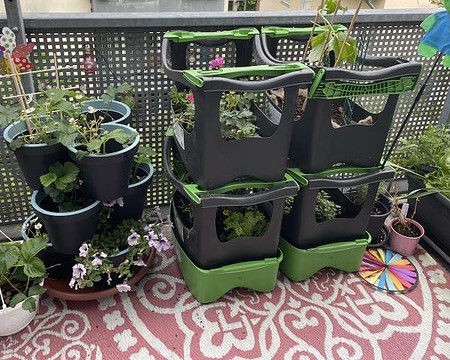By Essi Karimi
About the Author:
Essy Karimi is an adventurous wordsmith who has a passion for reading, hiking, and writing (although she occasionally indulges in a friendly tango with procrastination)
If you live in an urban area but love gardening, you’re likely familiar with the challenges of finding a suitable space to nurture your green thumb. Amid the concrete jungle, your desire to connect with nature and grow plants may often feel constrained. However, there’s a solution that can transform your tiny balcony into a flourishing oasis: vertical gardening.
The gardening solution uses a “gardening up” practice where you can use various structures to elevate plant growth and take advantage of vertical space. The practice provides a practical and aesthetically pleasing way to maximize your limited balcony space. With it, you can indulge in your passion for plants regardless of how small or high-rise your living environment may be.
This article teaches you how to create a stunning verticle garden on your balcony. Within no time, you’ll enjoy stepping into your patio and being greeted by a vibrant tapestry of greenery, a symphony of scents, and the satisfaction of tending to your garden.
To create a flourishing vertical garden on your balcony, you need to:
Table of Contents
Assess Your Balcony Space
Before you start gardening, you need to assess your balcony space to know how much space you have to work with and how much room you have for plants. This will help you determine the appropriate size and number of vertical structures or containers you can use without overcrowding the area. Once you get an idea of the pace you’re working with, you also need to consider the following:
- Different plants have varying sunlight requirements, and understanding your balcony’s sunlight exposure will help you choose plants that will thrive in those conditions.
- The growing conditions, including the intensity of light, shade, and protection from the rain, will influence the types of plants that will grow well in your balcony garden and help you create a successful vertical garden.
- Balconies have weight limits, and it’s essential to ensure that your vertical garden, including the plants, containers, and supporting structures, does not exceed the weight capacity of your balcony. Assessing your space will help you plan accordingly and avoid potential safety hazards.

By carefully assessing your balcony space, you can create a successful and visually appealing vertical garden with the most available room and growing conditions.
Choose the Right Plant
Choosing the right plants for vertical gardening is essential for a successful and visually appealing garden. The following plants are suitable for vertical gardens due to their growth habits, adaptability, and low maintenance requirements:
Bromeliads
Bromeliads are tropical plants with a shallow root system, ideal for vertical gardens. They can adapt to various light conditions and are known for their colorful foliage and unique flower structures.
Ferns
Ferns are versatile plants that can thrive in various light conditions, from bright to indirect to low light. They have shallow root systems and can easily adapt to vertical garden setups.
Begonias
These flowering plants are known for their attractive foliage and vibrant blooms. They can grow well in vertical gardens due to their compact size and adaptability to light conditions.
Hostas
Hostas are shade-loving plants with lush foliage that can add texture and visual interest to vertical gardens. They have a shallow root system, making them suitable for growing in limited soil spaces.
Succulents
Succulents like Echeveria are popular for vertical gardens due to their low water requirements, shallow root systems, and diverse forms and colors. They can easily adapt to various light conditions and require minimal maintenance.
Air plants
Air plants (Tillandsia) do not require soil to grow, making them perfect for vertical gardens. They absorb water and nutrients through their leaves and thrive in various light conditions.

Choose the Right Vertical Gardening Structures and Containers
Once you decide on what plants you want to plant in your vertical balcony garden, it’s time to choose a gardening container or structure. What you use depends on various factors, such as:
- Sturdiness: Choose materials that are strong enough to support the weight of the plants and growing medium.
- Drainage: Proper drainage is crucial for the health of your plants. Ensure your chosen containers have adequate drainage holes to prevent waterlogging and root rot.
- Size and depth: Select appropriately sized containers for the plants you plan to grow. Consider the root systems of your chosen plants and ensure the containers provide enough space for healthy root development.
- Adaptability: Look for structures and containers easily attached to walls, fences, or other surfaces. This allows you to make the most of your space and create a visually appealing garden.
- Ease of maintenance: Consider how easy it will be to water, fertilize, and maintain your vertical garden. Due to their design, some structures and containers may require more frequent watering, so choose options that suit your maintenance preferences.
- Aesthetics: Select structures and containers that complement your garden’s design and style. This can include matching colors, materials, and shapes to create a cohesive and visually appealing garden.
- Versatility: Opt for structures and containers that accommodate various plants, including vines, flowers, and vegetables. This allows you to create a diverse and exciting vertical garden.
Considering the above factors, here are some vertical gardening structure and container ideas you might want to try:
Stack Planters
Stack planters have multiple tiers that are lightweight and easy to stack on top of one another. They are available in various sizes, shapes, and colors, allowing you to choose your desired gardening style. You can place them in any location as their design promotes efficient water drainage, ensuring your plants receive the right moisture.
Railing Planters
If you have a railing or fence on your balcony and want to start a garden, railing planters are your best planting containers. They have a design that allows them to attach to railings, fences, or other surfaces. They can accommodate a variety of plants, including herbs, leafy greens, and small flowering plants, making them a versatile option for vertical gardening.
Hanging Baskets
You can suspend these baskets from above, making them ideal for limited spaces or balconies. They can hold various plant types, including flowers, ferns, and succulents. You can maximize water recycling efficiency with hanging baskets by placing them above raised planter beds.
Trellises
If you like climbing plants, you can use trellises to provide support and allow them to grow vertically to save space. You can attach them to walls and fences or use them as freestanding structures in your garden to grow vines, tomatoes, and cucumbers.
Follow the Right Verticle Balcony Gardening Practices
Once you plant your vertical balcony garden, you must ensure the right gardening practices for successful results. The following tips can help:
Proper Watering Techniques
Vertical gardens can dry out quickly, so watering them regularly is essential. Consider watering in the morning to allow the plants to absorb moisture before the day’s heat sets in. You can use a long-spout watering can or set up a drip irrigation system for more efficient watering.
Soil Selection and Fertilization
Choose the right soil and fertilize as needed to ensure healthy plant growth. Opt for a high-quality potting mix that provides adequate drainage and nutrients. Add organic matter or slow-release fertilizers regularly to maintain soil fertility.
Plant Maintenance and Pruning
Always inspect your plants for pests and diseases, and remove any affected parts promptly. Prune plants to maintain their shape, encourage bushier growth, and remove dead or damaged foliage. This improves air circulation and prevents the spread of diseases.
Rotating Plants for Optimal Sunlight Exposure
Ensure your plants receive enough sunlight by placing your vertical garden in an area with adequate light. Rotate plants to provide even sunlight exposure, especially for those that require more light to thrive. This promotes healthy and even growth for all plants in your vertical garden.
Bottom Line
Vertical gardening offers numerous benefits for balcony spaces, making it an ideal solution for urban dwellers and gardening enthusiasts with limited space. By utilizing vertical surfaces such as walls, fences, and trellises, you can maximize your growing area, create stunning living art pieces, and enhance the beauty of your home.

